Trout Fishing in Chester County, PA
A creek — several in fact — runs through it
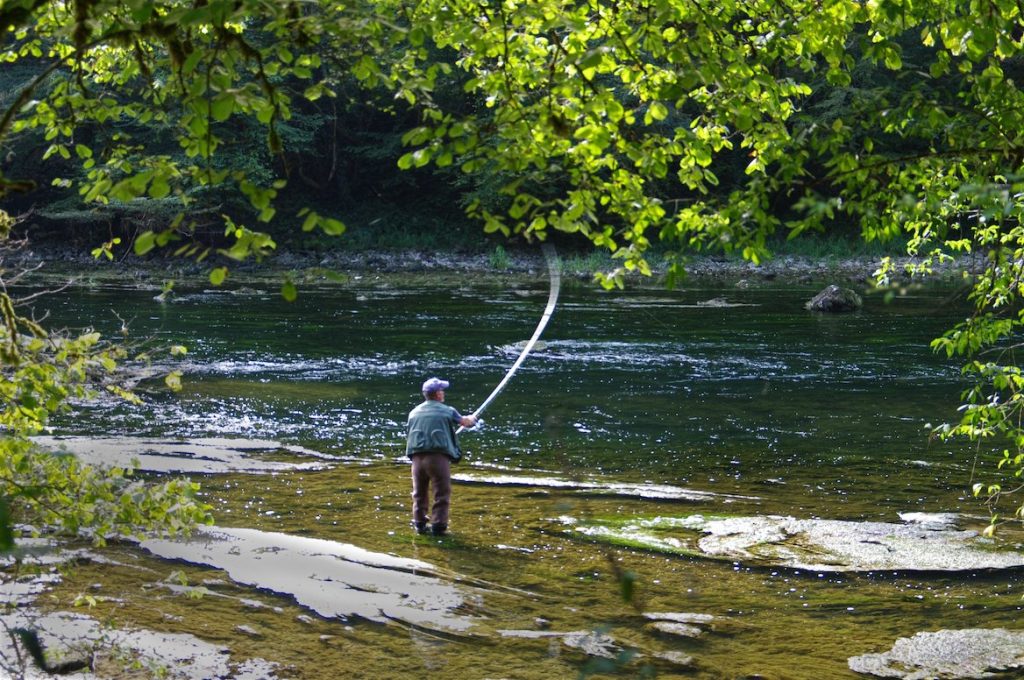 There are more than 18,000 wild trout waters in our state, according to Pennsylvania’s Fish and Boat Commission. But fewer than 40 are in Chester County, and only three of those are “Class A” streams — streams with a population of “naturally produced trout of sufficient size and abundance to support a long-term and rewarding sport fishery.” Most of the remaining 40 are “stocked.”
There are more than 18,000 wild trout waters in our state, according to Pennsylvania’s Fish and Boat Commission. But fewer than 40 are in Chester County, and only three of those are “Class A” streams — streams with a population of “naturally produced trout of sufficient size and abundance to support a long-term and rewarding sport fishery.” Most of the remaining 40 are “stocked.”
There are also several fishing streams in surrounding counties. But getting to any of them in the right season and at the right time of day, then tempting a trout with an appropriate lure, and finally landing one … well, that’s where things get complicated. We’re here to help make things simpler if you’d like a fresh-caught trout dinner.
About Trout
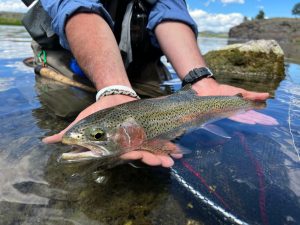
First, some background on the fish themselves. In southeast Pennsylvania, there are generally four kinds of trout: brown, rainbow, golden rainbow and brook. They grow to be 20 years old and 40 pounds or more. But it’s at 3 to 4 years and at about 10 to 12 inches that they’re best for eating.
Nearly all the trout placed in the stocked streams in our area are raised in state-run hatcheries. The main hatchery for our local trout is Huntsdale Fish Hatchery near Carlisle. The hatchery process begins when collected eggs are mixed with sperm, and then the hatched fish are transferred to successively larger tanks. Later they’re trucked to, and eventually released into, the streams in two to three years. Typically, in February through May, and once in October, the 3- to 9-inch fingerlings will be released to the creeks of Chester County.
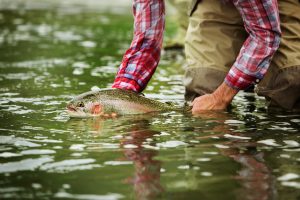
After release, the trout are most often found in cool water — 68 to 70 degrees or less. Water temperature limits their population. Most of our local streams reach this temperature by mid-June and don’t cool down until October, causing summer anglers to look for shade or deep pools with cooler spots or certain streams with cool water. For instance, the limestone spring that supplies Valley Creek or the tailwaters from the Blue Marsh Dam on the Tulpehocken Creek near Reading have cool temperatures.
About Trout Fishing
As for trout fishing, you can catch trout with a spinning rod and live bait. A worm or night crawlers may do. In fact, you can even catch trout in a net, though that’s illegal.
For many of us, though, trout fishing is synonymous with fly fishing. Thirty-some years ago, in the film A River Runs Through It, based on the Norman Maclean book, Brad Pitt lived a life fly fishing in the brilliant mountain streams of Montana. We all want to do some of that!
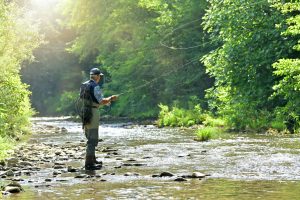
That dream, however requires some education, some equipment, some supplies. You’ll need a good map, time to fish early or late in the day to avoid midday heat, and familiarity with state regulations. If you’re over 16, you’ll need a license. And know there are limits on the size and number of trout you may catch and keep. (In designated “catch-and-release” areas, that number is zero.) And there are also sections of streams that have other restrictions, like size, lures, season, number of fish per day.
One way to get started is with a visit to an Orvis store. There’s one in Downingtown, where Dan Kowalchuk, the Fishing Manager, and Tony Cadwalader, a retail associate, will provide expert advice. At the TCO Fly Shop in Bryn Mawr, Steve Turrisi is another good information source. There, if you don’t already have a fly rod, fly reel, fly line, waders, vest and several flies, you can get outfitted. You’ll also need a net, assuming you get lucky. Lest you’re wondering, outfitting yourself for fly fishing is not cheap, but at Orvis lessons are free. TCO’s lessons start at $100 per hour.
Actually Fishing
Now that you know a little about trout and have the necessary gear, it’s time to think about the magic of fly fishing. Casting your fly to the right spot, placing the fly delicately in the vicinity of a hungry trout, and allowing the fly to drift downstream with the current are the most picturesque parts of trout fishing — you’re living the movie scene.

Choosing your fly, however, may be one of your biggest challenges — the right colors and pattern, the right hook size, the right action. Your aim is to imitate the aquatic insects that trout are feeding on. These insects change with the season — first as eggs, then moving from their larval or nymph stage, up the water column and into their adult and flying stage, ultimately dropping their eggs annually into the stream again.
You need to follow the life cycle of the stream closely. In August, for example, the blue wing olive and tan caddis predominate on Valley Creek. Then the light olive caddis prevails in September. Midges are good all year round. Because of the changing environments, experienced anglers may carry a couple dozen flies with them.
Anglers, you should note, may tie their own flies, but that specialized hobby is for another day.
Trout Streams Around Chester County
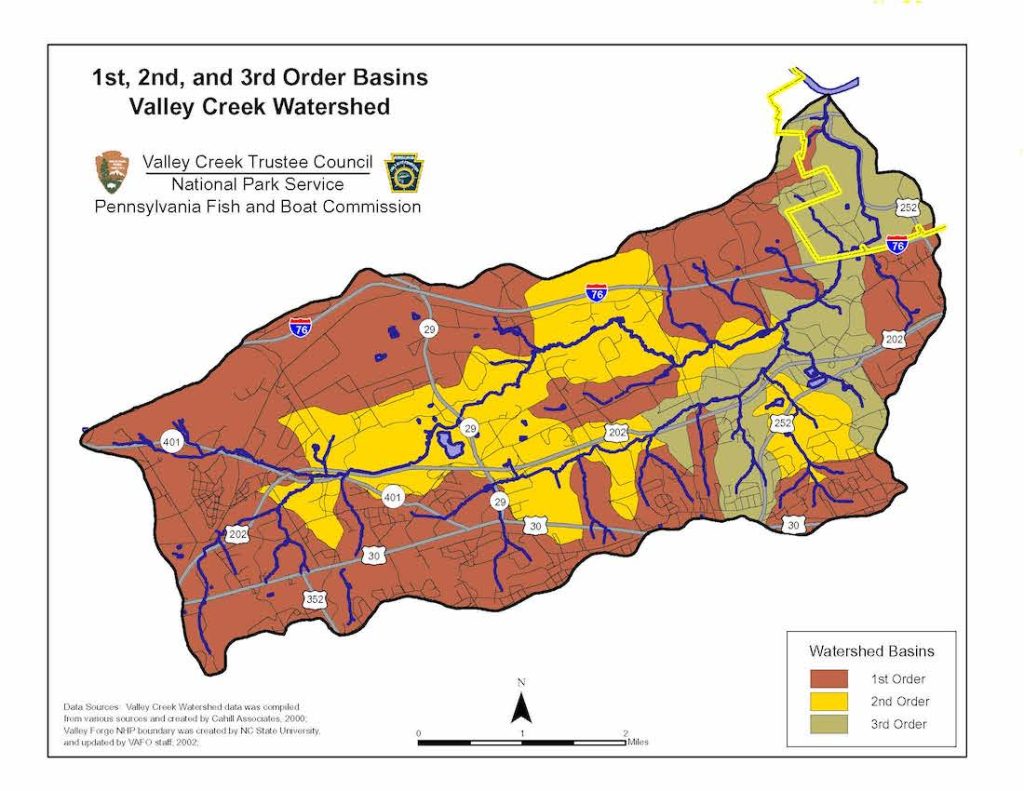
The three Class A streams in Chester County are all tributaries of Valley Creek, an unstocked stream flowing through Great Valley and Valley Forge National Park. The water remains below 70 degrees even in the hottest months, is well oxygenated and has a high pH, which supports a rich insect population. Valley Creek is about seven miles long, 15 to 20 feet wide, and is home to a significant population of brown trout.
The fall is the best season to fish Valley Creek to catch large fish, but spring and summer are also enjoyable. There are many access points for fly fishermen. Several are off interstate highway I-76 on the upper part of the stream.
Another good spot, Tulpehocken Creek — the Tully, as it’s known — is a 40-mile-long tributary of the Schuylkill River, located near Reading in Berks County, about an hour northwest of West Chester. The state stocks that creek with rainbow and brown trout. The cool and fertile tailwaters of the nearby Blue Marsh Dam are also good for fishing. Below the dam, there are four miles of good water with many trout averaging between 12 to 14 inches.
Usually below 70 degrees, the Tully will often get a strong dose of cool water from the dam release, reinforced by two downstream creeks. These tributaries — the Plum and Cacoosing Creeks — are good alternatives if the waters of the Tully are running high.
For northern Chester County fishing, French Creek is a good option. It begins in Lake Hopewell, stretching downstream for 14 miles, and is heavily stocked. Best fished in the spring, French Creek does still have some cool spots for summer. Trout fishing picks up again in the fall. The uppermost section, where a few trees help keep the water cool, is ideal for trout. Most of the aquatic insects here are caddisflies, although there are a few mayflies as well, so choose your flies accordingly.
Another option is the 24-mile-long Little Lehigh Creek, in Lehigh and Berks Counties, about 90 minutes from West Chester. You’ll find convenient fishing access throughout the Allentown park system and great fishing in limestone-fed water that’s cool all year round.
There are many other rivers, streams and creeks in Chester County and beyond that are also great for fly fishing. And it’s worth noting that a variety of fish other than trout — bass, muskies, walleye, pike — are fun to catch on fly fishing gear.
So, grab a rod, pick a fly and try your luck. Worst case, you’ll spend the day by the fresh water and in fresh air, thinking about the river of life. Best case, you’ll get a delicious dinner.
For more about local trout fishing, check out the Pennsylvania Fish and Boat Commission, FishAndBoat.com, or DIYFlyFishing.com.
